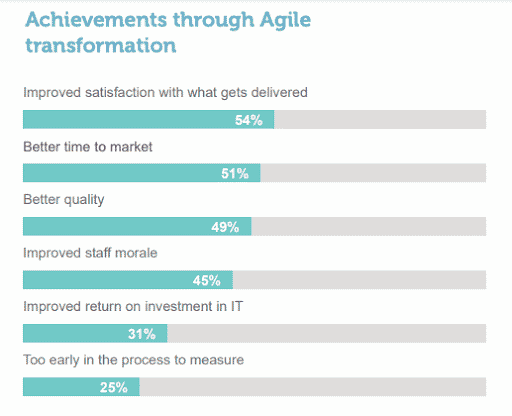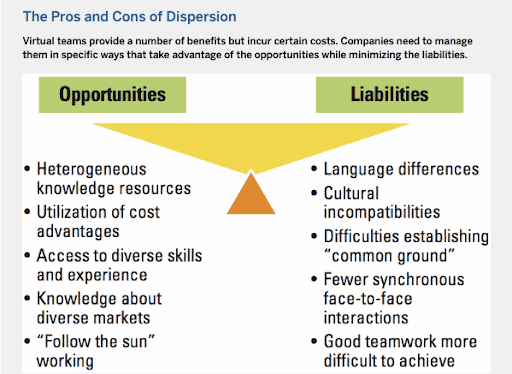If you haven’t gone agile yet, what are you waiting for?
Over half of organizations that adopt agile practices (specifically scrum) report higher satisfaction with deliverables and better time-to-market. About the same number report improved product quality and staff morale.

But that’s not all.
Distributed agile development can result in even greater productivity gains — if you build your team right, that is.
Here’s how to do it.
What is agile development?
Unlike the traditional linear or “waterfall” approach to software development, agile is cyclical. It breaks projects into series of rapid delivery cycles, also known as sprints or iterations.
At the end of each cycle, the development team releases a fully functional application. They then review the result with the customer and create requirements for the next sprint, after which they deliver an updated product.
What is distributed software development?
Distributed development doesn’t rely on in-house IT teams — or not exclusively, anyway. Instead, some or all of the engineers working on an app or another software product are based in a nearby country, which is why this model is also known as nearshoring.
The in-house and remote teams collaborate closely, have shared tasks and common goals, and communicate regularly. Think of them as one team, only “distributed” across international borders.
Studies show that a remote software development team will often outperform a fully colocated workforce — as well as realize significant cost savings and unlock access to a broader talent pool — if you follow a few management best practices when building it.

How to build Distributed Agile Development Teams
The best part about distributed and agile software development is that the two mix well together.
Here are five distributed agile best practices to set your location-independent agile teams up for success:
1. Migrate all processes online
Ensuring effective collaboration and communication between in-house and distributed teams was hard enough before the pandemic. Now, as remote work settles into a permanent fixture, this has become more challenging than ever.
Agile development usually requires daily scrums and meetings. In a post-COVID world, you need to take these and any other collaborative activities fully online to accommodate not only distributed but also remote in-house employees.
2. Allocate tasks strategically
One secret to successful agile software development with distributed teams is to divide tasks across physical locations as well as based on each individual’s skills.
Allocate tasks and deliverables across your in-house and external developers and be sure to onboard remote teams properly, explaining:
- Each development cycle phase
- Team roles
- Project goals
- Customer requirements
- Your expectations
- Evaluation criteria
This helps diversify skills in each location and, crucially, creates a safety net in the event of work disruptions in one of the teams. Diverse and well-balanced skill sets also facilitate team autonomy and ownership of the product.
3. Ensure optimal team size
As a rule of thumb, you want to keep each distributed agile development team between three to 10 members. This allows for easier collaboration, communication, and project planning. If possible, try to also match time zones by ensuring that all team members are based in the same or neighboring countries.
4. Promote collaboration
We said it before, and we’ll say it again: The biggest challenge with distributed agile development is ensuring effective collaboration between groups and individual team members.
This goes beyond aligning geographical locations and syncing time differences. Distributed agile teams can also face language barriers and cultural differences, so making sure everyone is on the same page at all times is paramount.
Good practices in this regard include:
- Daily meetings and planning sessions
- Regular and effective communication of tasks
- Using online collaboration tools like Zoom and Slack
5. Reduce dependencies in software development
Agile systems perform at their best when they allow team members to work simultaneously on as many development cycle phases as possible instead of waiting for someone to finish something first. Reducing such dependencies is key to developing successful agile projects.
Distributed Agile Development Best Practices
Your work isn’t done once you build your agile team. You also need to manage it on a daily basis — and do it properly. These agile practices can help with that:
Ensure task traceability and accountability
Once each individual gets assigned their tasks, team leaders must be able to track who does what and whether it’s completed properly and on time.
Luckily, there is a wealth of agile project management tools you can choose from. These can help you get into the habit of marking tasks as “In progress,” “Stuck,” or “Done” to reduce the need to ask for updates, minimize communication challenges, track project progress, and know instantly when a deliverable is overdue.
Make use of low-code development
Low-code development isn’t suitable for all agile projects, but where it is, it’s much faster than high code. Low-code platforms facilitate collaboration and make it easier for both technical and non-technical teams to work remotely. It’s also easier for non-technical users to identify and resolve issues.
The result? Increased agility, better product development, and faster time-to-market.
Have proper distributed agile team structure & governance
Each agile team should have a scrum master responsible for planning sprints whose goals fit into the larger product delivery timeline. A well-thought-out agile team structure is especially important in large-scale projects with multiple stakeholders such as in-house developers, business teams, clients, and outsourced teams.
But above all, an effective governance team needs a shared vision, plan, and timeline. These high-level KPIs and performance reviews, rather than the nitty-gritty, are what help carry the bigger picture.
Consider outsourcing distributed development
For even greater productivity and time savings, consider outsourcing your software development. Distributed agile teams often perform best as seamless outsourced additions to your in-house staff.
You can hand-pick the right talent and specific skills you need while saving time and money on figuring out hiring across different locations. And for the most part, software outsourcing companies have agile capabilities and adapt easily to distributed development. They can also share their knowledge and experience on agile processes, best practices, and distributed software development tools.
Looking for a distributed development partner you can trust?
If you’re ready to give remote development a try, you’ve come to the right place.
At Zartis, distributed agile development is our forte. We specialize in building stellar dedicated teams who work for our clients from various locations worldwide.
Our developers will support you from the project initiation phase all the way to when your product hits the market.
Contact us today to learn how our agile software development teams can radically transform your business.

